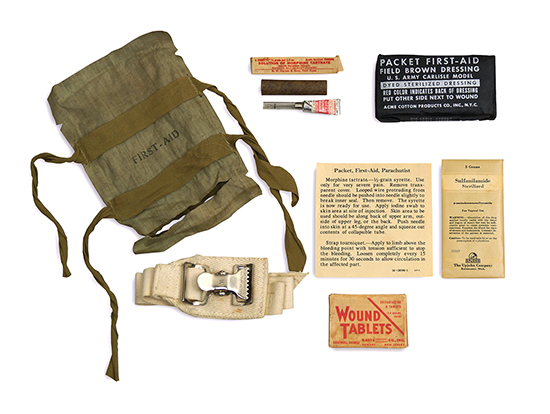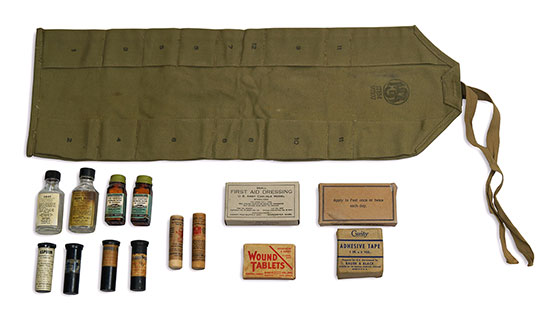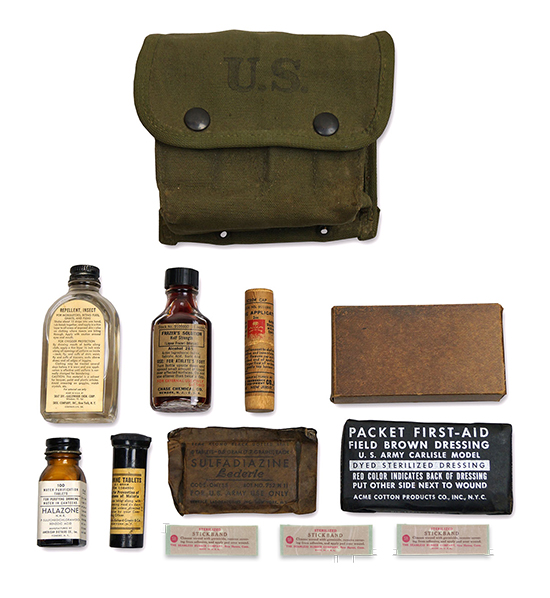Individual First-Aid Kits Medical Kits & Contents
This article has been produced to show the different individual first-aid and medical kits offered to frontline fighting troops. These kits were issued to the ordinary fighting men, and would be used for administering first-aid prior to the arrival of a medic. Please click on the illustrations to enlarge.
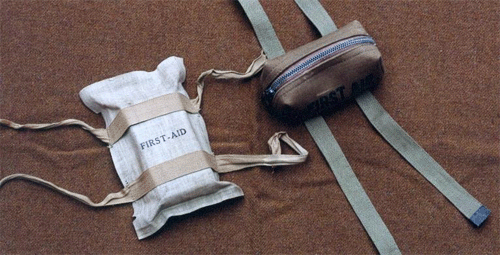
Picture showing Packet, First-Aid, Parachute (second pattern) and Packet, First-Aid, Parachute (first pattern) . The first pattern was in fact specially designed for the Air Corps, and was very much in use with flying personnel of the Army Air Forces, it can be seen from time to time being worn by Airborne Officers.
The above Packet is the second pattern specially designed for and issued to Army Air Forces personnel, and often used by Airborne troops (in special circumstances also in use with the first assault waves on D-Day, June 6, 1944 – especially Special Engineer Brigades and Infantry units). The Kit consists of a waterproof container, with a double set of ties allowing it to be fastened to any type of equipment. The front part bearing the designation FIRST-AID was to be worn exposed. The F-A Packet was to be worn within easy reach, and could be opened by tearing either end, when needed. Early versions did not include all the items listed above, and according to AAF Manual 55-0-1 5 (First Aid Equipment, General, 1 June 1945-11-A-1) they merely consisted of a single Small White First-Aid Dressing, a Field Tourniquet (loose or packed in a cardboard sleeve), and one Morphine Tartrate Syrette, also protected by an individual Cardboard Box.
This item did not seemingly undergo any official modifications in 1943-44. It should however be noted that, according to many sources, the Packet included an Instruction Sheet with directions for use and recommendations covering Morphine and Tourniquet (although not listed). The Packet was slightly adapted after mid-1944 to include a Package of 8 Sulfadiazine Tablets, as well as a box containing 5 Shaker Envelopes of Crystalline Sulfanilamide, although this is NOT reflected in the June 1945 AAF Manual!
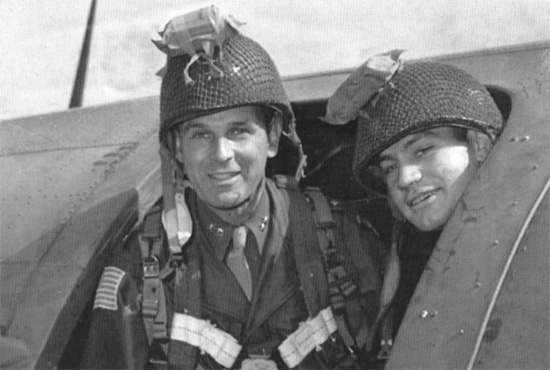
Illustration showing wear of the Packet, First-Aid, Parachute by Major General Maxwell D. Taylor (101st A/B Div) and Lieutenant Colonel Patrick F. Cassidy (502d PIR). Both men pose in the doorway of a C-47 prior to Operation “Market Garden”.
Following general tendencies (as with other Kits), the White-colored Dressing changed into Field Brown in 1945, and the Field Tourniquet was later replaced by the Elastic version; the Crystalline Sulfanilamide Shaker Envelopes were abandoned, since it was deemed better to keep only the Sulfadiazine Box.
The First-Aid Parachute Packet was supplied to each Air Force crew member and Parachutist. For the AAF The Packet was to be fastened securely to the Parachute Harness on the right lift web, opposite the ripcord grip with the label exposed, of course this only applied to aircrews, as we all know; being already overburdened with full gear, and provided with different Parachute versions, Paratroopers obviously followed different rules … just look at the numerous pictures illustrating wear of the F-A Parachute Packet. It must be noted that quite a number of British-made Shell Dressings were provided as well for use during “Operation Market-Garden”.
Prior to D-Day, and mainly due to its size and practicability the Parachute First-Aid Packet was issued and successfully used by troops of armored units for the invasion of France.
In January 1945, approximately 16,000 Packets, First-Aid, Parachute, modified by the addition of one Tube of Boric Acid Ointment, were received from the ComZ medical authorities. The tube of boric acid ointment now included replaced the Tourniquet. These units were issued to all Armored Divisions on a basis of 2,000 per Division. (the above information was supplied by AMEDD and was also found in TUSA Reports on the fighting in Belgium and Luxembourg –ed).
The M-1 Kit was the first version introduced for use in the jungle. It failed because it was unpractical and too bulky and was eventually replaced by the M-2 version. The M-1 Individual Medical Jungle Kit, introduced in 1942-1943, consisted of a khaki-colored lightweight cotton kind of sleeve, provided with 17 individual compartments, that was rolled up and tied for easy packing. The only item to be cancelled early 1944, were the 100 Salt Tablets; the rest of the items remained, although later limited in number, when replacing the Kit with the M-2 version (smaller container, limited contents). The packed Kit rolled, and tied together as a kind of bag was to be carried in a compartment of the Jungle Pack ; the trouble was, that is was not only fragile, but often out of reach for the owner; it however remained in limited use, even after the introduction of the new M-2 version…
It does look obvious and it is, the M-2 version of the Jungle Kit replaced the M-1 type which was found to be rather unpractical, mostly out of reach, and too large. The present Kit was introduced in 1944, and proved an immediate success with the troops (both Army and Marines would use it); its Container hooked into the eyelets of either the Pistol or Cartridge Belts, was within easy reach of the wearer, and could be opened or closed by two press studs; contents were sometimes modified by the owner, depending on his personal taste and/or foresight. The M-2 Individual Medical Jungle Kit was only manufactured in olive-drab canvas; it was supplied to each soldier fighting in jungle areas…

Illustration showing outer cardboard box containing one complete M-2 Jungle Kit. This particular example has been manufactured by W & K Mfg. Co., New York, N. Y.
This photograph is courtesy of Kriss Usherwood, and used with his kind permission.

